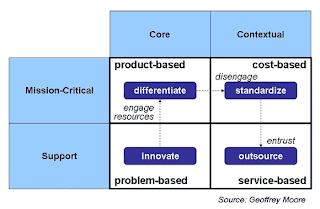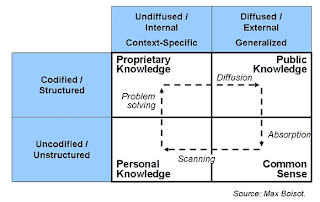Here are some of the key points.
1. For years Tesco differentiated itself from the competition by writing its own e-commerce software that fitted in perfectly with its processes.
2. Competitors who tried to copy this software were unable to replicate its internal functionality. (Nick refers to "special algorithms".)
3. But the "core systems" are not Tesco's "core business". So Tesco has decided to outsource.
4. Tesco selected an e-commerce software platform that matches its core systems the closest.
5. With the core already there, Tesco will devote its IT staff to designing and developing new business improvements and ideas.
Analysis
This story fits with the view of "services on the fault line", which the CBDI Forum adopted and adapted from Geoffrey Moore. Capabilities migrate around the grid. The core e-commerce platform is migrating from top-left to bottom-right; meanwhile Tesco is devoting its internal IT resources to generating new functionality from bottom-left.
The classification of capabilities depends partly on the link to business outcomes / value. It also depends on the knowledge associated with each capability. Correct decoupling between capabilities depends on encapsulating the knowledge (know-how) embedded in each capability. (This is a version of the well-known architectural principle: separation of concerns.)
So we can understand the strategic cycle of capabilities (core and contextual) proposed by Geoffrey Moore, by reference to a model of the knowledge cycle proposed by Max Boisot.

I don't know whether the "special algorithms" remain proprietary to Tesco, or whether they (or at least the "commodity" provided by these algorithms) become available to other users of the same platform. In any case, I guess Tesco will be looking to develop new and more sophisticated algorithms.
See also
CBDI Forum, SOA Fundamentals (2009) - key extract from page 222
Richard Veryard and Philip Boxer, Metropolis and SOA Governance (Microsoft Architecture Journal 5, July 2005). Philip Boxer and Richard Veryard, Taking Governance to the Edge (Microsoft Architecture Journal 6, August 2006)
Richard Veryard, Business Strategy Planning for the Service Economy (CBDI Journal May 2006)
In his post Managing over the whole Governance Cycle (April 2006), Philip Boxer extends the Boisot model to produce a governance cycle appropriate for the platform-based business. See also my post on Knowledge and Culture (April 2006).
Related posts: Service Planning (December 2006), Ecosystem SOA (October 2009) Ecosystem SOA 2 (June 2010)
Updated 13 October 2015. Links updated 18 November 2019
Hello Richard,
ReplyDeleteYes your analysis is correct and you have clearly shown the key points and the 'freeing up' of IT developers to concentrate on business improvements and ideas once the core is outsourced to ATG's software.
Thanks,
Nick Lansley
It's an interesting step, using ATG for Tesco Direct -- a classic e-commerce service. I’ll be interested to see how it goes; I hope it works well for the business. (I must admit, I would have loved to see this done with a UK company, but of course I do appreciate the international scope of this.)
ReplyDeleteIt's great that Tesco is continuing to build on its in-house .Net technology, with ASP.Net for the grocery business which of course has been so successful.
I can't help but be hugely impressed by what Tesco has achieved online over the past decade, and by its continued success in the traditional bricks-and-mortar grocery business. It's a shining example of a British business.
I'm pretty excited about the company's expansion into online entertainment, too!
techfortesco.blogspot.co.uk/2009/03/background-to-tescocom-adopting-atg-e.html
ReplyDeleteWith now Tesco working on ATG, how was the experience with infosys and adv. after ATG being acquired by oracle.